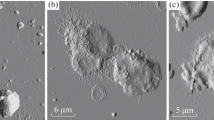Abstract
The bactericidal and opsonic activity of fresh human serum (FHS) for a mucoid strain ofPseudomonas aeruginosa, 144M, and its spontaneous nonmucoid revertant, 144NM, was examined. Strain 144M was sensitive to the bactericidal activity of FHS, but strain 144NM was not. This bactericidal activity was due to the combined interaction of IgG and IgM with complement, activated through both pathways. Neither 144M nor 144NM was ingested by human polymorphonuclear leukocytes (PMNL) without FHS. Whereas maximal phagocytosis of 144M required only 5% FHS, comparable ingestion of 144NM required 25% FHS. Maximal phagocytosis of either 144M or 144NM required IgG, IgM, and complement. However, 144M required a heat-sensitive opsonic IgG, whereas 144NM required a heat-resistant IgG. Using selective absorption techniques, the targets for bactericidal and opsonic immunoglobulins on 144M and 144NM appeared to be different, suggesting that the variant 144NM had one or more altered, absent, or inaccessible cell surface components that account for differences in response to FHS and PMNL.
Similar content being viewed by others
Literature cited
Baltimore, R. S., Mitchell, M. 1980. Immunologic investigations of mucoid strains ofPseudomonas aeruginosa: comparison of susceptibility to opsonic antibody in mucoid and nonmucoid strains. Journal of Infectious Diseases141:238–247.
Bjornson, A. B., Michael, J. G. 1974. Factors in human serum promoting phagocytosis ofPseudomonas aeruginosa. I. Interaction of opsonins with the bacterium. Journal of Infectious Diseases130:S53-S59.
Diaz, F., Masovich, L. L., Neter, E. 1980. Serogroups ofPseudomonas aeruginosa and the immune response of patients with cystic fibrosis. Journal of Infectious Diseases121:269–274.
Doggett, R. G. 1969. Incidence of mucoidPseudomonas aeruginosa from clinical sources. Applied Microbiology18:936–937.
Eidinger, D., Bello, E., Mates, A. 1977. The heterocytotoxicity of human serum. I. Activation of the alternative complement pathway by heterologous target cells. Cellular Immunology29:174–186.
Fine, D. P. 1977. Comparison of ethyleneglycoltetraacetic acid and its magnesium salt as reagents for studying alternative complement pathway function. Infection and Immunity16:124–128.
Gallin, J. I., Clark, R. A., Frank, M. M. 1975. Kinetic analysis of chemotactic factor generation in human serum via activation of the classical and alternative complement pathways. Clinical Immunology and Immunopathology3:334–346.
Gibbs, D. L., Roberts, R. B. 1975. The interaction in vitro between human polymorphonuclear leukocytes andNeisseria gonorrhoeae cultivated in the chick embryo. Journal of Experimental Medicine141:155–171.
Griffin, Jr., F. M. 1977. Opsonization, pp. 85–113. In: Day, N. K., Good, R. A. (eds.), Biological amplification systems in immunology. New York: Plenum Medical Book Co.
Hoiby, N., Olling, S. 1977.Pseudomonas aeruginosa infection in cystic fibrosis. Bactericidal effect of serum from normal individuals and patients with cystic fibrosis onP. aeruginosa strains from patients with cystic fibrosis or other diseases. Acta Pathologica et Microbiologica Scandinavica, Section C85:107–114.
Mayer, M. M. 1961. Complement and complement fixation. pp. 133–153. In: Kabat, E. A. Mayer, M. M. (eds.). Experimental immunochemistry, 2d ed. Springfield: Charles C. Thomas.
Ogle, C. K., Ogle, J. D., Stinnett, J. C., Stace, P., Alexander, J. W. 1980. Different serum requirements for opsonization of two serologically identical strains ofPseudomonas aeruginosa. Immunological Communications9:677–691.
Roe, E. A., Jones, R. J. 1974. Intracellular killing of different strains ofPseudomonas aeruginosa by human leukocytes. British Journal of Experimental Pathology55:336–343.
Schiller, N. L., Friedman, G. L., Roberts, R. B. 1978. Role of serum factors in the phagocytosis of type 4 gonococci by human polymorphonuclear leukocytes, pp. 207–212. In: Brooks, G. F., Gotschlich, E. C., Holmes, K. K., Sawyer, W. B., Young, F. E. (eds.), Immunobiology ofNeisseria gonorrhoeae. Washington: American Society for Microbiology.
Stossel, T. P. 1973. Quantitative studies of phagocytosis. Kinetic effects of cations and heat-labile opsonin. The Journal of Cell Biology58:346–356.
Thomassen, M. J., Demko, C. A. 1981. Serum bactericidal effect onPseudomonas aeruginosa isolates from cystic fibrosis patients. Infection and Immunity33:512–518.
Thomassen, M. J., Demko, C. A., Boxerbaum, B., Stern, R. C., Kuchenbrod, P. J. 1979. Multiple isolates ofPseudomonas aeruginosa with differing antimicrobial susceptibility patterns from patients with cystic fibrosis. Journal of Infectious Diseases140:873–880.
Young, L. S., Armstrong, D. 1972. Human immunity toPseudomonas aeruginosa. I. In vitro interaction of bacteria, polymorphonuclear leukocytes, and serum factors. Journal of Infectious Diseases126:257–276.
Author information
Authors and Affiliations
Rights and permissions
About this article
Cite this article
Borowski, R.S., Schiller, N.L. Examination of the bactericidal and opsonic activity of normal human serum for a mucoid and nonmucoid strain ofPseudomonas aeruginosa . Current Microbiology 9, 25–30 (1983). https://doi.org/10.1007/BF01567129
Issue Date:
DOI: https://doi.org/10.1007/BF01567129




